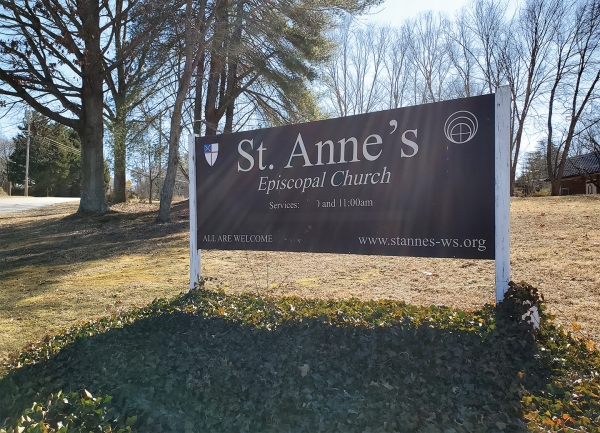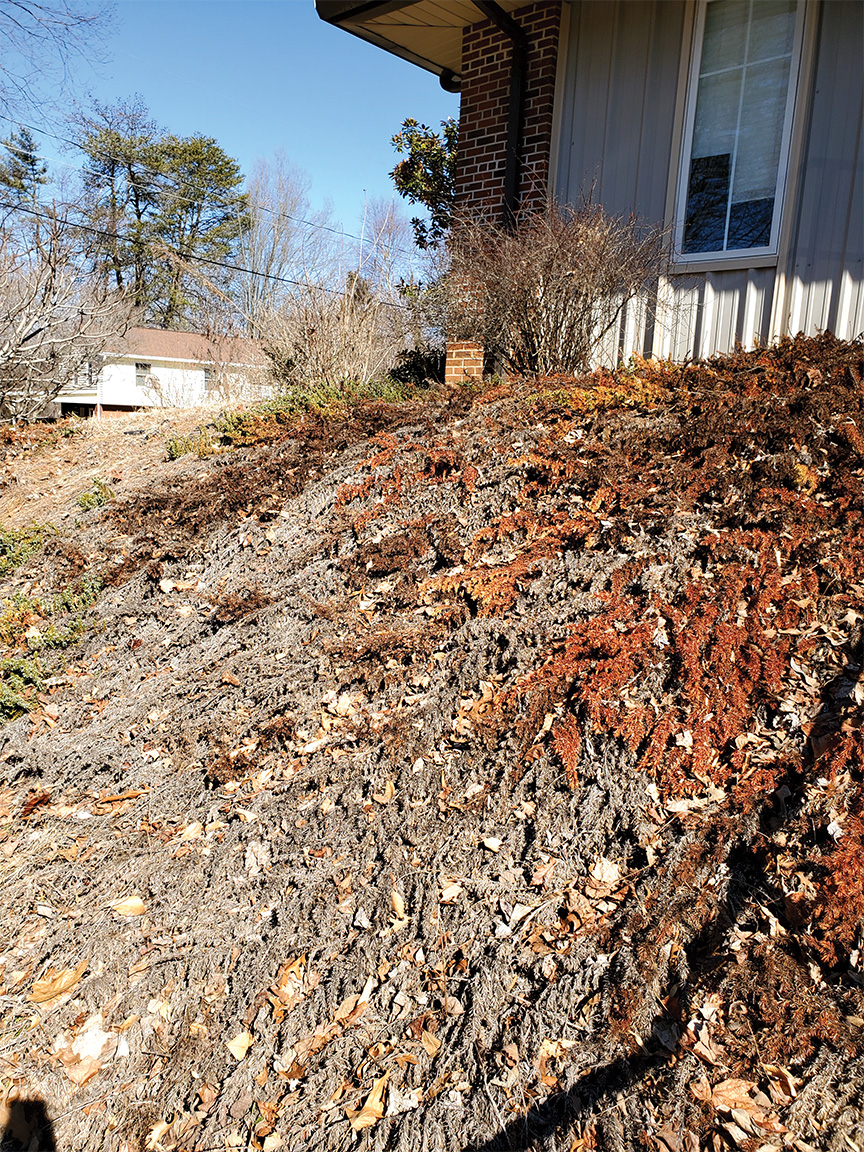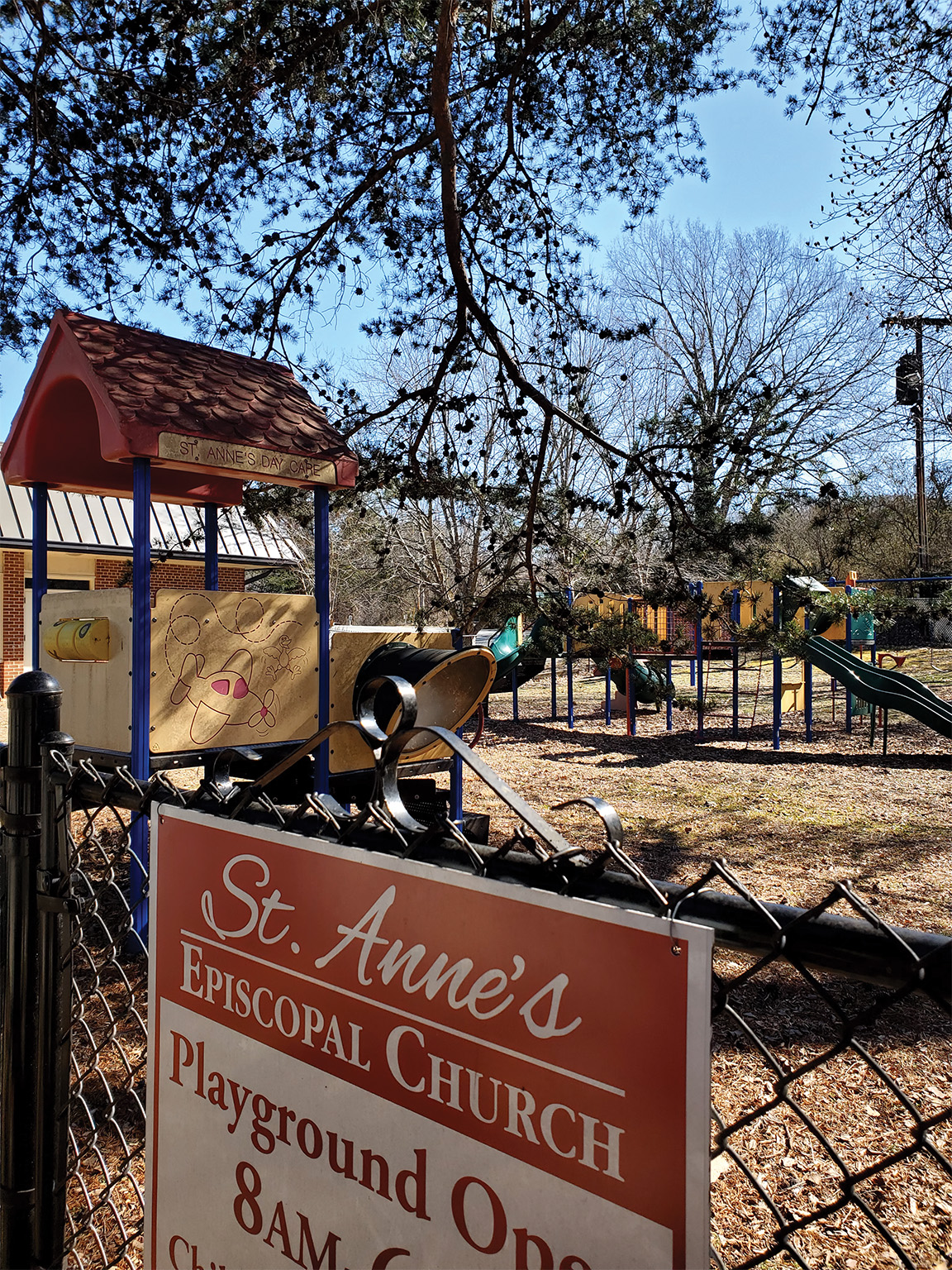Disciple: Widening the Welcome

St. Anne’s new plan extends a welcome far beyond the church
By Christine McTaggart
When you think of what it means to welcome, where does it start for you? With an unlocked and open door? With a heartfelt hello? The offering of food or beverage?
The parishioners of St. Anne’s, Winston-Salem, are reimagining what it means to welcome, even when those they are welcoming never set foot in the church.
“When people walk through our doors, the people of St. Anne’s are incredible at making them feel welcome and at home,” said the Rev. Ginny Wilder, rector of St. Anne’s. “What we’d like to do now is widen that welcome to extend to the whole neighborhood and everyone who happens by.”
[An inaccurate sign parallel to the road does not reflect the vibrant welcome visitors find inside St. Anne’s, Winston-Salem. The church is working to change that. Photos throughout by the Rev. Ginny Wilder]
FRESH EYES
After months of pandemic and working from home, in November 2020, Wilder returned to her church office and began spending more time there. Often the only one on the grounds, most of her time was spent indoors with a focus on providing online worship each week in a way that allowed the close-knit congregation to come together and participate as they did when they were together in person.
But then came the time in 2021 when parishioners could gather in person and worship outdoors. Spending time outside the building preparing for and celebrating outdoor worship gave Wilder a new perspective, and she saw the St. Anne’s campus with fresh eyes. What she saw gave her pause.
“I saw the grounds from a different point of view,” she said. “I wasn’t just walking from the parking lot to the building or out to the mailbox. What I saw didn’t look so good. It certainly wasn’t sending the right message. The pandemic limited what we were doing within the building, but it looked like we were shuttered and weren’t there anymore.”
She began walking the grounds with intention, identifying areas that needed attention. As she did, she also began to wonder: What if these areas weren’t just fixed but instead were transformed into a form of welcome to the wider community and used as a way of sharing what St. Anne’s holds so dear?
A HUB OF HOSPITALITY

“For years, we were known as St. Anne’s of the Folding Chairs,” said Wilder. “Everything happened in one space. After worship, chairs were folded up to become the parish hall or, during the week, an indoor gym for the childcare facility. We’ve gotten pew chairs over the years, but the humility remains, and I think that’s been one of the draws for folks. It’s so understated, but when you arrive inside, you know very quickly it’s the people that really make it a church, because it’s clear what’s important is the people. The building is just where we do what we do.”
At the time it was built, St. Anne’s was on the outskirts of town; today, its grounds are on what is now a main road that takes travelers to downtown Winston-Salem, past Wake Forest University or to a nearby shopping area. Estimates are more than 10,000 cars drive that road every day. An apartment complex is within walking distance of the church, and nearby property was recently sold for a new housing development of more than 200 homes. Four non-denominational churches have been built in the last two years.
[Image: Dying landscaping around the church caught the Rev. Ginny Wilder's eye as she walked the grounds of St. Anne's, Winston-Salem.]
As Wilder imagined ways the exterior offerings of St. Anne’s could send a message of welcome to the community, she realized it had the potential for an even deeper impact. “This is not just about doing a refresh,” she said. “If folks can find us and see the welcome we’re extending, we potentially will be the first liturgically oriented church they encounter in this area if they’re seeking a place to call their spiritual home.”
With a new perspective, Wilder identified several areas that provide an opportunity to widen the welcome and project the vibrancy of St. Anne’s:
- Church sign—Although thousands of cars pass by every day, many of them don’t see St. Anne’s sign of welcome since it sits parallel to the road. With an angle adjustment and a new look, what is now easily missed can become a beacon.
- Dedicating parking spaces as electric vehicle charging stations—Reflecting the importance of creation care, this improvement is two offerings in one. It fulfills a need, as there are not many charging stations in St. Anne’s area of Winston-Salem, and those using the stations can enjoy the Peace Garden while their vehicles recharge.
- Disabled parking spaces—Though close to the entrance walkway, the disabled parking spaces are currently exposed to the elements, making it difficult for those who take more time to enter or exit their vehicles. Covering those spaces and adding lighting will protect from the elements those who use the spaces, removing weather as a deterrent to participating in activities.
- Walkway—With cracks and pitfalls, the walkway leading from the parking lot into the church can be tough to navigate for those not sure-footed. The hope is to replace the walkway with a new, level and covered path complete with lighting, making the approach to the church both pleasant and safe.
 Playground—In days past, the St. Anne’s playground served a day care center that no longer operates. Its current location in a secluded area at the back of the church served the day care well, but, with apartments nearby that house families but offer no recreational space for children, St. Anne’s hopes to relocate the playground to the front of the church and implement contemporary safety features.
Playground—In days past, the St. Anne’s playground served a day care center that no longer operates. Its current location in a secluded area at the back of the church served the day care well, but, with apartments nearby that house families but offer no recreational space for children, St. Anne’s hopes to relocate the playground to the front of the church and implement contemporary safety features.- Cemetery—The cemetery at St. Anne’s is almost full, so the question under consideration is what options can be offered for those who wish St. Anne’s to be their final resting place.
- Trees—Some of the trees that populate the grounds of St. Anne’s are in need of evaluation for care. Some can be saved, while others may need to be removed. Those removed can be replaced with food-bearing or other service-oriented species.
- Flower beds in back parking lot—The plant life in the beds that line the building as visitors approach from the back parking lot largely consists of juniper, and it is not doing well. The hope is to replace it with native plants.
The only indoor area identified as an opportunity to widen the welcome is a seldom-used restroom near the entrance. With ADA-compliant restrooms available in another part of the building, the idea for the unused restroom is to transform it into a unisex, family restroom.
ADDING VOICES
As the idea continued to grow in Wilder’s mind, a retreat was held for the incoming vestry. Conversation centered on examining the high and low points of the pandemic and the vision of what the church could be moving forward. Many of the ideas and directions brought forward mirrored the thoughts on Wilder’s mind.
“It was nice to hear [what I saw] echoed by other people who aren’t spending 40-plus hours a week in the building,” she said. “But what we all have in common, first, is our faith in God, and, second, that we practice that faith at St. Anne’s. We all want to have an outward symbol of the hope and the joy and the community within our building, what we experience when we work and worship together.”
Early conversation centered on the installation of solar panels, but, upon learning the church would need to replace its roof membrane within 10 years, the timing of going solar wasn’t right.
Not wanting to lose the energy around creating outward signs of welcome and health, Wilder assembled a video of ideas and possibilities. She shared it with St. Anne’s after Christmas and invited any and all who wanted to be part of the conversation to two meetings in early 2022, one for initial conversation and the second to go deeper in conversation after some time for thought.
After the ideas were gathered and the voices heard, Wilder compiled all potential projects into a survey and once again extended it so the congregation could add their thoughts or any last ideas and prioritize how the projects would be—or could be—approached. When the survey results were shared, conversation continued not just on how the projects could be done but how to be ready for the impact they might have.
“Part of widening the welcome definitely includes an invitation for people to come worship with us,” said Wilder. “So now we’re thinking about how we can use our parish hall, thanks to the technology that we have, as a way of opening up more space for people to worship if they don’t want to sit too close to somebody else.”
MAKING IT HAPPEN
St. Anne’s is now entering the phase of making it all happen. A group of parishioners is assisting with assembling the cost of the top-priority projects so that plans can be made for how to approach the funding. It will likely be a creative mix of budgeting, fundraising, grant applications and networking.
“I scour the grants and am reaching out to folks with knowledge of that world and who can help us navigate it,” said Wilder. “We’re also having a lot of conversations with people and churches who have undertaken interesting and inspiring projects to see what ideas and connections might be shared or developed.”
On the day she spoke with the Disciple, Wilder was meeting with a consultant from Forsyth County to walk the property and assess needs and possibilities. Through the county’s Master Gardner program, soil testing can be done to determine what will grow best and a plan developed for the native flowers, trees and shrubs most likely to flourish.
As the plan develops, the one thing that is likely to prove hard to determine is the timeline. Even if every needed dollar suddenly appeared, disruptions to supply chains have made resources scarce for the contractors who will do the work. Recent projects undertaken by St. Anne’s that normally would take weeks, if not days, have taken months to complete. “It’s a long, patient process,” said Wilder.
While the hope is supply issues will lessen as 2022 progresses, there is plenty of work to do to get ready. St. Anne’s is preparing not just to widen the welcome but to meet the world again as it continues to reopen.
“I keep reminding folks that we are not going to go back to normal,” said Wilder. “We haven’t gone through the pandemic to return to where we were. God doesn’t meet us where we were, God meets us where we are.
“We’re moving forward, and we’re doing it in faith and somewhat as a baptism. We don’t enter into the waters of baptism and come out the other side without any changes. We have entered into the waters of the pandemic, and we have to let ourselves be changed by that, otherwise we’ve missed the opportunity to be transformed.”
For those who may be exploring how to widen their own church’s welcome, Wilder’s advice is: pray.
“Pray for your parishioners by name,” she said. “Imagine them if they haven’t been in church for a while, what might be welcoming to them when they do return. Pray for your neighborhood and imagine what the daily life is for your neighbors and what would be welcoming to them, even if they just drive by.”
Conversation is also key, and having a starting vision helps to get the conversation started. It should be only a starting point, though, so clergy, lay leaders and parishioners all have a chance to be part of the dreaming. Include as many voices as possible, for the multiple experiences and points of view will ensure the dream is rich and wide-ranging.
For the parishioners of St. Anne’s, the hope is their exterior plans to widen their welcome will exemplify the beauty of the people folks will find inside.
“We want to welcome folks,” said Wilder. “Even if they never step foot in the building, if they drive by and say ‘wow, that’s a pretty place’ or ‘wow, my kids would like that playground’ or ‘wow, they have electric car charging stations, nobody else has those near us,’ they know there’s a place for them here. It’s building hospitality in terms of anticipating every need, both expressed and unexpressed. For me, widening the welcome kind of takes on that mantra.”
Christine McTaggart is the communications director for the Diocese of North Carolina.
